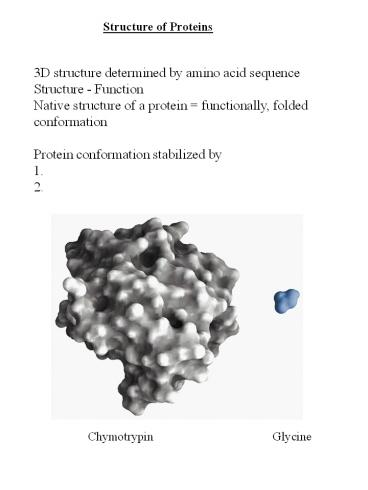Structure of Proteins - PowerPoint PPT Presentation
1 / 30
Title:
Structure of Proteins
Description:
... abnormal bone formation in babies Ehlers-Danlos syndrome - loose joints Both diseases involve: ... H-bonds between different sheets Made by: ... – PowerPoint PPT presentation
Number of Views:84
Avg rating:3.0/5.0
Title: Structure of Proteins
1
Structure of Proteins
3D structure determined by amino acid
sequence Structure - Function Native structure of
a protein functionally, folded
conformation Protein conformation stabilized by
1. 2.
Chymotrypin
Glycine
2
Structure of Proteins
3D structure determined by amino acid
sequence Structure - Function Native structure of
a protein functionally, folded
conformation Protein conformation stabilized by
1. disulfide bonds 2. weak noncovalent
interactions (H-bonds, hydrophobic ionic)
Chymotrypin
Glycine
3
3D Structure of Proteins
Primary structure Peptide bond is rigid and
planar
4
3D Structure of Proteins
Primary structure amino acids linked
together Peptide bond is rigid and planar
5
Secondary Structure of Proteins
Important elements - Basic types of secondary
structure Helices, Sheets, Turns and Coils
? Helices
H-bond
6
Secondary Structure of Proteins
Important elements - steric clashes
H-bonding Basic types of secondary structure
Helices, Sheets, Turns and Coils
? Helices
H-bond
7
Secondary Structure of Proteins
- ? Helices
- Ionic interaction between R groups of AAs three
residues apart
Arg
Asp
8
Secondary Structure of Proteins
? sheets Backbone is extended into a zigzag
structure Arranged side-by-side to form a
structure (pleats) Important Forces
Layering of gt2 sheets R groups must be small
(Gly, Ala)
9
Secondary Structure of Proteins
? sheets Backbone is extended into a zigzag
structure Arranged side-by-side to form a
structure (pleats) Important Forces H-bonds and
steric clash
Layering of gt2 sheets R groups must be small
(Gly, Ala)
10
Secondary Structure of Proteins
? turns Occur frequently in globular proteins,
180 turn involving 4 Aas Used to 1. Reverse
direction of polypeptide chain 2. Connect ?
helices/? sheets and within ? sheets Important
forces Amino acids used Gly - because it is
small and flexible Pro - because of cis
conformation of peptide bond forms a tight turn
11
Secondary Structure of Proteins
12
Tertiary Structure
Overall 3D arrangement of all atoms in a
protein Long range contacts between AAs in a
single polypeptide chain
13
Quarternary Structure
Long range contacts between AAs in a different
polypeptide chain
14
Fibrous Proteins
Mainly structural role
15
Fibrous Proteins
?-Keratins Found in mammals, provide
strength Hair, wool, nails, claws, quills, horns,
hooves, skin
Strengthened by Disulfide bonds
16
Fibrous Proteins
?-Keratins Permanent waving of hair 1. Reduce
disulfide bonds 2. Moist heat breaks H-bonds and
causes uncoiling of ? helix 3. Remove reducing
agent, add oxidizing agent, new S-S bonds
17
Fibrous Proteins
- Collagen
- ? helices, left-handed helix with 3 amino acids
per turn - 35 Gly, 11 Ala, 21 Pro/4-Hyp
- (Gly-X-Y) repeat with X as Pro and Y as 4-Hyp
- Coiled-coil, three separate polypeptides called ?
chains are supertwisted - Provide strength (stronger than ??)
- Connective tissue (tendons, cartilage, organic
matrix of bone, cornea)
18
Fibrous Proteins
Collagen Rigid and brittle bones caused
by Crosslinks in collagen fibrils over time
Gly-X-Y repeat important - single change
results in disease Osteogenesis imperfecta -
abnormal bone formation in babies Ehlers-Danlos
syndrome - loose joints Both diseases involve
mutation of Gly to a different amino acid
19
Fibrous Proteins
Silk Fibrous protein of silk Fibroin Secondary
structure present ? sheets Forces involved
H-bonds between different sheets Made by
insects and spiders Silk does not stretch because
it is already highly extended
20
Fibrous vs. Globular Proteins
21
Globular Proteins
? helices and ? sheets and ? turns and
noncovalent interactions Arrangement of
different secondary structural elements Compact
conformation Folding provides structural
diversity Globular proteins enzymes, transport
proteins, motor proteins, regulatory proteins,
immunoglobulins, etc. First understanding of
globular proteins came from x-ray structure of
myoglobin (oxygen-binding protein in muscle)
Iron protoporphyrin (heme)
Single polypeptide chain
??helix
? turn
22
Globular Proteins
Other important forces in globular proteins
____________ aa
23
Globular Proteins
Other important forces in globular
proteins Hydrophobic interactions
Hydrophobic aa
24
Globular Proteins
Well-studied example Myoglobin Flat heme group
rests in crevice of protein
25
Globular Proteins
Variety of Tertiary Structures
Disulfide bond
Heme
Disulfide bond
Respiratory chain in mitochondria
Egg white and human tears Cleaves polysaccharides
Enzyme secreted by pancreas Hydrolyzes RNA
26
Protein Denaturation Folding AA sequence
determines tertiary structure
Importance of native structure Loss of structure
loss of function
27
Protein Denaturation Folding Rapid stepwise
folding
28
Protein Denaturation Folding
Defects in folding may lead to disease AA
mutation in CFTR - cystic fibrosis BUT No AA
mutation (except in inherited forms) just
misfolding in (PrP) Prion Protein
29
Protein Denaturation Folding
Proteins undergo assisted folding molecular
chaperones assist in folding
30
- What type of protein has an extended shape?
- Fibrous
- Globular
- Tertiary
- Chaperone































